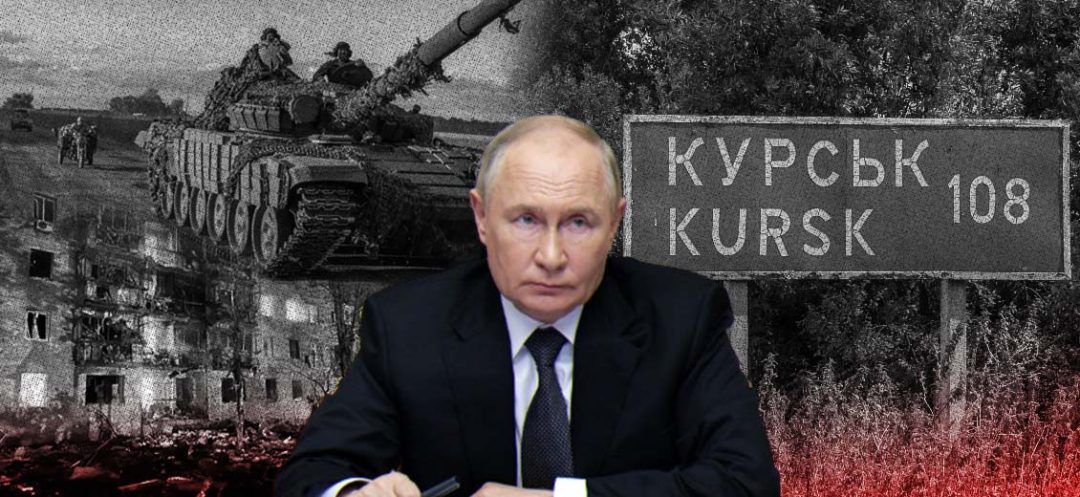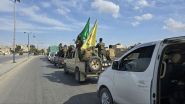- Home
- Middle East
- Role Reversal: Ukraine's 'Special Military Operation' in Russia

On August 6th, more than two years into Vladimir Putin's "special military operation", Ukraine launched a "special military operation" of its own. It is a risky gambit, but one that may be crucial in eventual peace talks.
At 5 a.m. on the 24th of February 2022, President Vladimir Putin addressed the Russian people from deep within the Kremlin, announcing the beginning of his so-called "special military operation."
As he spoke, Russian armored columns crashed through Ukrainian border checkpoints, and elite VDV paratrooper units flew low along the Dnipro River, heading for key airfields in the Kyiv suburbs.
Putin expected the operation to last a matter of days, yet, 907 days, and approximately 500,000 deaths, later, Kyiv remains defiant.
Yet, recent days have shocked the world, following Ukraine's surprise counter-offensive into Russia's Kursk region. It is now the blue and yellow banner of Ukraine being hoisted over Russian towns.
Ukraine's counter-attack
On the morning of August 6th, Ukrainian forces stormed through border defenses in Russia’s Kursk region, catching Moscow off guard and marking the first time a foreign army has captured Russian territory since World War II.
While the exact scale of the deployment remains uncertain, Russia estimates 1,000 Ukrainian troops were involved, contrasting with the U.S.'s belief that the number may be tenfold.
Ukraine's top military commander, Oleksandr Syrsky, claimed to have seized over 1,150 square kilometers and 82 settlements, surpassing Russia's territorial gains in Ukraine in the past seven months of conflict.
In response, Russia has evacuated over 200,000 people from border areas. Despite Russia's assertion of "stabilizing" the front, Ukrainian President Vladimir Zelensky reports that the offensive is progressing well, highlighted by the full capture of Sudzha.
The incursion is clearly a symbolic victory. Putin’s casus belli in Ukraine was to protect the Russian people from the encroaching threat of hostile anti-Russian nations. Yet this incursion “has brought the war to Russian civilians—something Putin has been trying to prevent from day one,” says Riad Kahwaji, Dubai-based director of the Institute for Near East and Gulf Military Analysis, to This is Beirut.
What Does Ukraine Hope to Achieve?
Ukraine has been on the back foot militarily for the past year, following its highly anticipated but largely unsuccessful 2023 summer offensive.
Since the lightning advances of the war’s first year, the conflict has become bogged down in the mud of eastern Ukraine. For the last 18 months, it has been a grinding slog of brutal attritional warfare, in which Russia has clawed gains at an eye-watering human cost.
Having suffered painful losses in 2024—most significantly, the fall of the bastion city of Avdiivka in February—it seems Ukraine is attempting to turn the tables and reestablish offensive momentum.
This Is Beirut spoke to Dominique Trinquand, the former head of the French military mission to the UN, who said that part of Ukraine’s reasoning is “to show the West that it must continue to support Ukraine”, that defeat isn’t inevitable, and that they retain the capacity to go on the offensive.
A senior Ukrainian presidential advisor, Mykhailo Podolyak, told NBC News that “Ukraine is not planning to occupy [Russian] territory” but that they will remain inside Russia “for as long as needed.”
However, according to Kahwaji, “the Ukrainians intend to keep this land with the intention of using it as leverage in peace talks.”
The U.S.-based think tank, Institute for the Study of War (ISW), has reported that Ukrainian forces have begun fortifying the captured territory, and their destruction of three key bridges in recent days—bridges that Russia would rely on to reinforce its frontline—suggests Kahwaji’s analysis may be accurate.
This development implies that Ukraine may be tacitly acknowledging the reality that its initial war aims—liberating all Ukrainian territory, long vowed by President Zelensky—may no longer be feasible.
Moreover, it suggests that senior Ukrainian officials are recognizing that peace talks are inevitable, and that it is better to strengthen their hand in advance.
Military Goals
Beyond political objectives, there appears to be a clear military goal to the incursion, according to both Trinquand and Kahwaji. Ukraine hopes to relieve pressure on the Donbas front by forcing Russia to redeploy its forces to defend Kursk.
However, it remains unclear how successful Ukraine has been in securing this aim.
While U.S. officials believe that Russia has diverted several thousand troops from the frontline in Ukraine to stem the attack, the ISW, citing sources in Western intelligence, claims that Russia is not redeploying its largest, most well-trained units.
This cuts both ways, with Ukraine’s decision to redeploy some of its veteran units in support of the offensive potentially placing the already beleaguered Donbas frontline under greater pressure.
ISW reports that Russia continues to advance in Donbas, despite Ukraine’s incursion into Russia, as they achieve progress in their attempt to encircle Pokrovsk—a key logistical hub.
A Risky Gambit
Whilst the Kursk offensive is certainly a daring gambit, it is not one without significant risk.
Questions remain over the issue of manpower. Ukraine’s military have sought to mobilize 500,000 more soldiers for the war effort, but efforts appear to be dragging.
According to General Trinquand: “Ukraine won't be capable of holding out on a wider front.”
Their military, undermanned and under pressure, risks being overstretched. As the battle lines get fixed and both sides dig in, Ukraine will be forced to defend an even longer frontline when it is already struggling to defend the existing one.
The offensive itself is also a “calculated risk,” says Kahwaji, envisioning a worst-case scenario in which Russia successfully launches a counteroffensive resulting in the encirclement and destruction of Ukraine’s troops.
The use of British-supplied Challenger 2 tanks in the incursion, as reported by the BBC, may provoke further saber-rattling in the Kremlin at increased Western involvement.
However, the risk of escalation remains low, according to Kahwaji, as the West has repeatedly crossed Putin’s purported “red lines” without meaningful recrimination. “There are not a lot of red lines left now,” he says.
At 5 a.m. on the 24th of February 2022, President Vladimir Putin addressed the Russian people from deep within the Kremlin, announcing the beginning of his so-called "special military operation."
As he spoke, Russian armored columns crashed through Ukrainian border checkpoints, and elite VDV paratrooper units flew low along the Dnipro River, heading for key airfields in the Kyiv suburbs.
Putin expected the operation to last a matter of days, yet, 907 days, and approximately 500,000 deaths, later, Kyiv remains defiant.
Yet, recent days have shocked the world, following Ukraine's surprise counter-offensive into Russia's Kursk region. It is now the blue and yellow banner of Ukraine being hoisted over Russian towns.
Ukraine's counter-attack
On the morning of August 6th, Ukrainian forces stormed through border defenses in Russia’s Kursk region, catching Moscow off guard and marking the first time a foreign army has captured Russian territory since World War II.
While the exact scale of the deployment remains uncertain, Russia estimates 1,000 Ukrainian troops were involved, contrasting with the U.S.'s belief that the number may be tenfold.
Ukraine's top military commander, Oleksandr Syrsky, claimed to have seized over 1,150 square kilometers and 82 settlements, surpassing Russia's territorial gains in Ukraine in the past seven months of conflict.
In response, Russia has evacuated over 200,000 people from border areas. Despite Russia's assertion of "stabilizing" the front, Ukrainian President Vladimir Zelensky reports that the offensive is progressing well, highlighted by the full capture of Sudzha.
The incursion is clearly a symbolic victory. Putin’s casus belli in Ukraine was to protect the Russian people from the encroaching threat of hostile anti-Russian nations. Yet this incursion “has brought the war to Russian civilians—something Putin has been trying to prevent from day one,” says Riad Kahwaji, Dubai-based director of the Institute for Near East and Gulf Military Analysis, to This is Beirut.
What Does Ukraine Hope to Achieve?
Ukraine has been on the back foot militarily for the past year, following its highly anticipated but largely unsuccessful 2023 summer offensive.
Since the lightning advances of the war’s first year, the conflict has become bogged down in the mud of eastern Ukraine. For the last 18 months, it has been a grinding slog of brutal attritional warfare, in which Russia has clawed gains at an eye-watering human cost.
Having suffered painful losses in 2024—most significantly, the fall of the bastion city of Avdiivka in February—it seems Ukraine is attempting to turn the tables and reestablish offensive momentum.
This Is Beirut spoke to Dominique Trinquand, the former head of the French military mission to the UN, who said that part of Ukraine’s reasoning is “to show the West that it must continue to support Ukraine”, that defeat isn’t inevitable, and that they retain the capacity to go on the offensive.
A senior Ukrainian presidential advisor, Mykhailo Podolyak, told NBC News that “Ukraine is not planning to occupy [Russian] territory” but that they will remain inside Russia “for as long as needed.”
However, according to Kahwaji, “the Ukrainians intend to keep this land with the intention of using it as leverage in peace talks.”
The U.S.-based think tank, Institute for the Study of War (ISW), has reported that Ukrainian forces have begun fortifying the captured territory, and their destruction of three key bridges in recent days—bridges that Russia would rely on to reinforce its frontline—suggests Kahwaji’s analysis may be accurate.
This development implies that Ukraine may be tacitly acknowledging the reality that its initial war aims—liberating all Ukrainian territory, long vowed by President Zelensky—may no longer be feasible.
Moreover, it suggests that senior Ukrainian officials are recognizing that peace talks are inevitable, and that it is better to strengthen their hand in advance.
Military Goals
Beyond political objectives, there appears to be a clear military goal to the incursion, according to both Trinquand and Kahwaji. Ukraine hopes to relieve pressure on the Donbas front by forcing Russia to redeploy its forces to defend Kursk.
However, it remains unclear how successful Ukraine has been in securing this aim.
While U.S. officials believe that Russia has diverted several thousand troops from the frontline in Ukraine to stem the attack, the ISW, citing sources in Western intelligence, claims that Russia is not redeploying its largest, most well-trained units.
This cuts both ways, with Ukraine’s decision to redeploy some of its veteran units in support of the offensive potentially placing the already beleaguered Donbas frontline under greater pressure.
ISW reports that Russia continues to advance in Donbas, despite Ukraine’s incursion into Russia, as they achieve progress in their attempt to encircle Pokrovsk—a key logistical hub.
A Risky Gambit
Whilst the Kursk offensive is certainly a daring gambit, it is not one without significant risk.
Questions remain over the issue of manpower. Ukraine’s military have sought to mobilize 500,000 more soldiers for the war effort, but efforts appear to be dragging.
According to General Trinquand: “Ukraine won't be capable of holding out on a wider front.”
Their military, undermanned and under pressure, risks being overstretched. As the battle lines get fixed and both sides dig in, Ukraine will be forced to defend an even longer frontline when it is already struggling to defend the existing one.
The offensive itself is also a “calculated risk,” says Kahwaji, envisioning a worst-case scenario in which Russia successfully launches a counteroffensive resulting in the encirclement and destruction of Ukraine’s troops.
The use of British-supplied Challenger 2 tanks in the incursion, as reported by the BBC, may provoke further saber-rattling in the Kremlin at increased Western involvement.
However, the risk of escalation remains low, according to Kahwaji, as the West has repeatedly crossed Putin’s purported “red lines” without meaningful recrimination. “There are not a lot of red lines left now,” he says.
Read more




Comments